Like a corset leaving little room for breathing, tight budgets curtail curatorial choices. The Henry Art Gallery is dipping into its collections for answers, which in Henry’s case is overdue. Aside from photography and contemporary art from Bill and Ruth True, what the Henry owns tends to be unexplored.
Part of the reason is unwieldy diversity. Only in the 1980s, under director Richard Andrews, did the Henry clarify its identity as a contemporary art venue, leaving the bulk of its collections with no reason to surface.
Besides contemporary art, these holdings range from historic photography, Horace C. Henry’s 19th-century landscapes; 19th-century prints, Japanese folk pottery, prints and ceramics as well as textiles, clothing and costumes from the U.S., Japan, Central Asia and Eastern Europe.
Under director Sylvia Wolf, the necessity of budget cuts fused with a genuine interest in making what’s best in the back bins accessible to the public. Costumes and textiles are available in depth online, with other collections to follow.
In its galleries, the Henry is making a virtue of its disconnects. The unfailingly deft associate curator Sara
Krajewski opened the year-long Vortexhibition Polyphonica with a fluid presentation of nearly 100 objects that make sense in their own company, despite disparities of time, media and place. In 2010, senior curator Elizabeth Brown will reshuffle the object deck.
Krajewski offers not just a noir Nan Goldin woman, but a corset her more modest mother might have worn in the 1950s.
Nan Goldin, Joey with her heart shaped breasts, NYC. 1999
Silver dye bleach (Cibachrome) print
25 9/16 x 38 1/8 in. (64.9 x 96.8 cm)
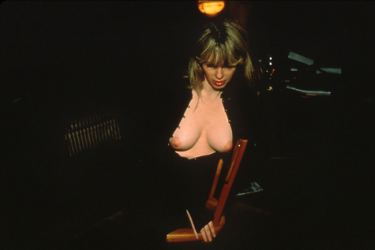
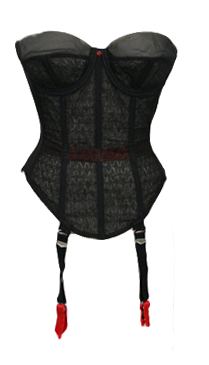 The exhibition’s title is a hat tip to E.V. Day‘s Cherry Bomb Vortex from 2002. (Red sequin dress with monofilament, turnbuckles, and stainless steel base
The exhibition’s title is a hat tip to E.V. Day‘s Cherry Bomb Vortex from 2002. (Red sequin dress with monofilament, turnbuckles, and stainless steel base
115 x 102 x 102 in.)
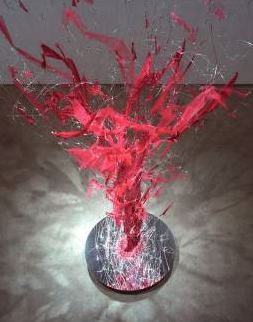 The dress is exploding, but the hat needs work. Rhythm, ladies and gentlemen, rhythm. Were the title Vortex Polyphonica instead of Vortexhibition Polyphonica, the point would have been clear and pronounceable, stylish even. As it is, it’s tone deaf and, with the suppression of the ex in exhibition, too cute.
The dress is exploding, but the hat needs work. Rhythm, ladies and gentlemen, rhythm. Were the title Vortex Polyphonica instead of Vortexhibition Polyphonica, the point would have been clear and pronounceable, stylish even. As it is, it’s tone deaf and, with the suppression of the ex in exhibition, too cute.
Better a bad title than a bad show. This one is a pleasure. The associations between objects are sometimes obvious but frequently subtle and intuitive. It asks viewers to create their own or simply enjoy shopping amid its multiplicity.
Morris Graves would have been pleased by the company he’s keeping, a Buddhist devotional hanging from the 17th or 18th century in silk damask and satin weave with embroidery.
Graves,
Sublime Buddha Gestures [study drawing]. 1935
Ink drawing and tempera on Japanese rice paper
17 7/8 x 13 7/16 in.
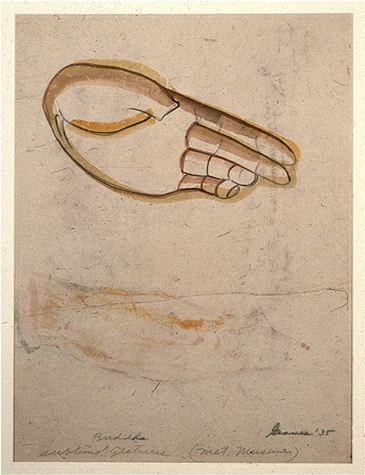 California funk is well represented along with Northwest fellow travelers, such as Clair Colquitt. The penis in the center is a replicia of his own. Turned on, it whirls like a drill.
California funk is well represented along with Northwest fellow travelers, such as Clair Colquitt. The penis in the center is a replicia of his own. Turned on, it whirls like a drill.
Table Top Air Purifier, 1975
Hand built and slab built earthenware with low fire underglazes, clear glaze and luster
20 7/8 x 19 7/8 x 17 3/8 in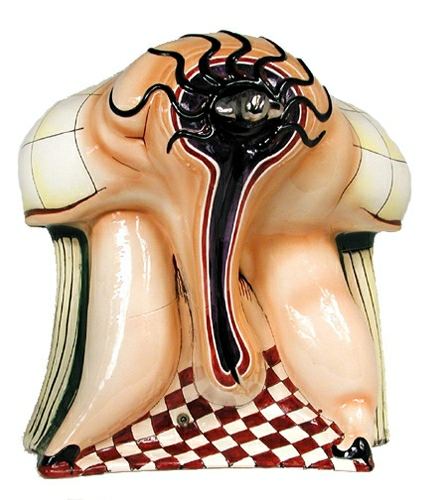 The spineless confront the rigid: Robert Longo’s color print Triptych: Men in the Cities from 1981 is pretty funny in the company of Axel Lieber
The spineless confront the rigid: Robert Longo’s color print Triptych: Men in the Cities from 1981 is pretty funny in the company of Axel Lieber
I Beam (Ich Strahl) from 2004.
Shoes for bound feet keep company with stilettos from contemporary high fashion.(If you think they have nothing in common, take a look at the bunions on the feet of models.) Nineteenth-century silk brocades mix and match with Pop art dresses from the 1960s. Arnulf Raine and Lucas Samaras make fiend faces beside Cindy Sherman’s high gothic.
I love Helmi Dagmar Juvonen‘s drawing, We Are the Seeds of Our Ancestors from 1955. Juvonen was the only woman in the Northwest School. She was hauled away into a mental for having too many cats and being in love with stalking Mark Tobey.The artists in her circle tended to take themselves and their spiritual
aspirations seriously. She was at hand to smack some
sense into them, rolling their fine ideas in her heavy, tender paws.
A pair of Gilles Barbier’s panoramic landscape photographs feature himself as a footnote of a footnote within their terrains. He had an exhibit at the Henry in 1999. I looked up my review and found it unrelentingly wrong. If I could walk back into the PI files and erase it, I’d be tempted.
Paint makes the world go round.
Jeffrey Simmons, Pontian,1997
Oil and alkyd on canvas
26 x 24 3/8 x 1 1/4 inches
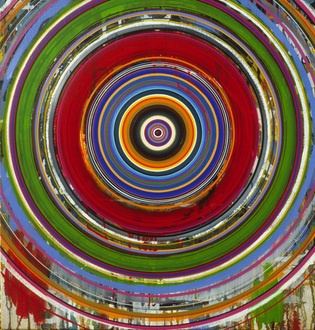 So does Howard Kottler. Just in time for same-sex marriage, his Look-Alike Plates from 1972. More images here. He’s a buried treasure.
So does Howard Kottler. Just in time for same-sex marriage, his Look-Alike Plates from 1972. More images here. He’s a buried treasure.
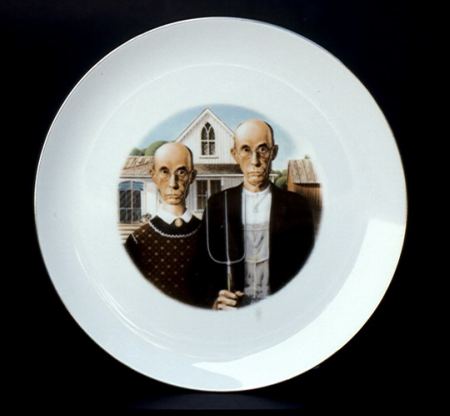



I love the Henry. I could spend days in this exhibit and not be done.
I don’t love the $8 it costs to get in. Nice to bring up this show. It looks cool and I’d like to see it, but come on, $8 when the northern galleries are shut down? Only half the galleries are open, and the admission price stays the same. Tell me another business that can get away with that.
Actually, if you look close enough admission, like the SAM, is by donation.
Hello Anonymous. The Henry’s general admission is $10, not $8. It’s free the first Thursday of every month. The north galleries are being renovated for the first time in decades. I think there is still $10 worth of art to see, but if you don’t agree, you can go on the free day. Unlike the Seattle Art Museum, the Henry does not offer the pay-what-you-can discount. If anyone’s getting that discount, the person at the front desk finds you especially appealing.
Thanks for correcting, Frank! Henry admission IS actually a suggested donation. And any student, with ANY student ID is always free. Thanks, on behalf of the Henry for the kind words, Beth.
(And thank YOU for the thoughtful review, Regina!)
Good to know about the Henry’s admission being a suggested donation, Betsey. Director Sylvia Wolf told me it wasn’t, and that info is not on your Web site, so I’m happy to pass the word.